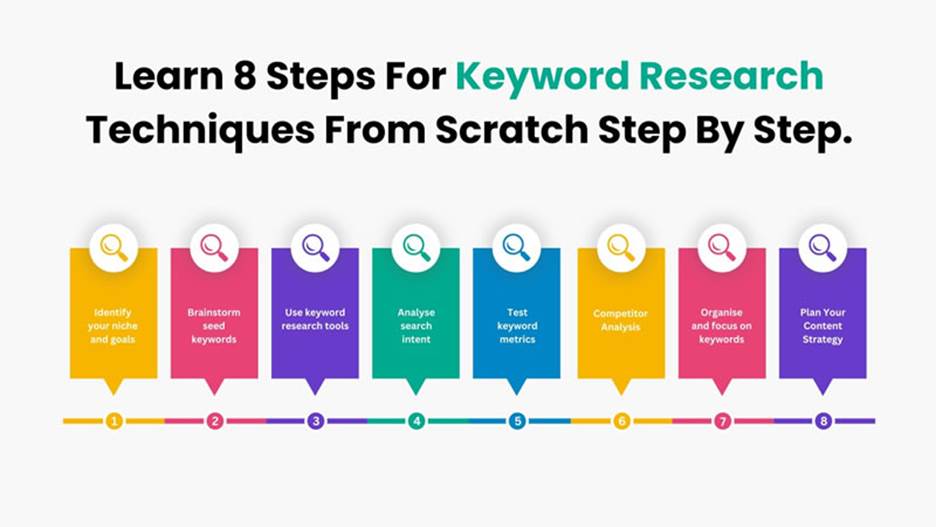If you need your site to rank higher on Google and pull in the right group of onlookers, the key lies in keyword research for SEO. For apprentices, it may sound complicated, but once you get the essentials, it becomes one of the most capable instruments in advanced marketing.
This direct will walk you through the fundamentals of compelling keyword research, clarify why it matters, and provide you with viable steps to begin building your own SEO keyword strategy.

What Is Keyword Investigate and Why Does It Matter?
The keyword research for SEO is the process of finding the correct words and expressions that individuals search for in search engines. By distinguishing these Keywords, you can create content that matches the client’s aim and increases your chances of positioning higher.
Think of catchphrases as a bridge between what individuals look for and the substance you give. Without them, your site risks being imperceptible to your target audience.
Step 1: Get it Look Intent
One of the first things to get a handle on is to look into the “why” behind a look inquiry. It’s not sufficient to know what individuals search for on Google; you need to get what they truly want, keyword research for SEO.
- Informational: The client needs information (e.g., “what is SEO catchphrase research”).
- Navigational: The client looks for a particular brand or location (e.g., “Google Catchphrase Planner”).
- Transactional: The client is prepared to take action, like buying or marking up (e.g., “best SEO device for beginners”).
By adjusting your catchphrases with expectation, you guarantee your content fulfills client needs.
Step 2: Begin With Seed Keywords
Seed catchphrases are essential terms related to your trade or specialty. For example, if you run a wellness web journal, seed Keywords might be “workout,” “nutrition,” or “weight loss.”
From these beginning focuses, you can grow into long-tail keywords for SEO like “best domestic workout for beginners” or “nutrition tips for weight loss.” Long-tail keywords are regularly less demanding to rank for and bring highly focused traffic and Content Marketing.
Step 3: Utilize Catchphrase Inquire about Tools
To burrow more profoundly, you’ll require solid password instruments for apprentices. Prevalent choices include:
- Google Keyword Organizer: free and awesome for finding keyword volume.
- Ubersuggest: beginner-friendly with keyword thoughts and SEO difficulty.
- AnswerThePublic: appears to be questions individuals inquire about your topic.
- SEMrush or Ahrefs: advanced tools for competitor keyword analysis.
Even free devices can offer assistance to reveal profitable keywords that coordinate with your audience’s needs.
Step 4: Analyze Your Competitors
A savvy portion of keyword research for SEO is learning from your competitors. See which catchphrases their substance positions for and recognize holes you can fill.
For example, if a competitor positions for “SEO content optimization” but doesn’t cover “keyword investigation examples,” you can step in with more total content.

Competitor catchphrase investigation is like spying for success, giving you a guide of what works in your industry.
Step 5: Center on Long-Tail Keywords
Beginners frequently target wide, exceedingly competitive terms like “SEO” or “digital marketing.” But these are too intense to rank for. Instep, center on long-tail catchphrases SEO.
These are longer, particular expressions with lower competition but higher change potential. For instance:
Instead of “SEO,” attempt “beginner’s direct to SEO keywords.”
Instead of “keyword research,” attempt “how to do catchphrase inquiry for blogs.”
This approach boosts your perceivability quicker and makes a difference in the clients you draw in who are closer to taking action.
Step 6: Organize Catchphrases with Catchphrase Mapping
Once you’ve accumulated Keywords, organize them with Keyword mapping for substance. This implies relegating particular keywords to particular pages of your site.
For example:
- Homepage: “SEO administrations for little businesses.”
- Blog 1: “How to do catchphrase inquiry for beginners.”
- Blog 2: “Best free keyword investigation tools.”
This anticipates substance cover and guarantees each page is optimized for a one-of-a-kind keyword set.
Step 7: Make Substance Around Keywords
After the investigation, it’s time to put the Keywords into action. The best way to utilize them is not to stuff them into each sentence.
Instead:
Place your essential Keyword in the title, meta description, and begin with 100 words.
Use related catchphrases in subheadings and all through the content.
Add LSI Keywords like “organic activity growth” and “SEO positioning factors” to donate context.
High-quality, keyword-optimized content builds a specialist and increases your chances of ranking.
Step 8: Track and Refine Your Keywords
SEO is never “set it and forget it.” Routinely track your keyword execution with tools like Google Analytics or SEMrush. See which Keywords drive activity and which require improvement.
Refining your keyword research for SEO over time guarantees your location adjusts to changes in search behavior and remains competitive.
Common Botches Tenderfoots Make in Catchphrase Research
Even with the right steps, tenderfoots frequently make these mistakes:
Targeting, as it were, high-volume Keywords, as well as competitive ones.

Ignoring the look expectation leads to unnecessary traffic.
- Keyword stuffing: harms lucidness and SEO ranking.
- Not overhauling Keywords: patterns and looks alter over time.
Avoid these, and you’ll be ahead of most fledglings in SEO.
The keyword to inquire about is the establishment of SEO victory. By understanding keyword research, utilizing the right tools, centering on long-tail keywords, and organizing your methodology, you can change your website’s visibility.
For fledglings, the way to compelling catchphrase inquiry isn’t about chasing each high-volume word; it’s about being vital, steady, and centered on client needs. With hone, your SEO catchphrase technique will not only bring activity but moreover construct long-term expertise in your specialty in keyword research for SEO.
Q1: What is the first step in catchphrase inquiry for SEO?
Start with seed catchphrases related to your specialty, then extend using keyword research tools to discover long-tail opportunities.
Q2: Which are the best free keyword research for SEO tools for beginners?
Google Keyword Organizer, Ubersuggest, and AnswerThePublic are amazing free tools for finding keyword thoughts and analyzing search volume.
Q3: How do long-tail catchphrases offer assistance in SEO?
Long-tail keywords have less competition, are focused on activity, and progress transformation rates, making them perfect for beginners.
Q4: How regularly ought I to overhaul my SEO keyword strategy?
At least every few months. Look patterns and competition move, so normal overhauls keep your substance important and effective.
Q5: Can tenderfoots truly do viable keyword research?
Yes. With the right instruments and steps, indeed, fledglings can construct a strong SEO catchphrase technique that drives natural activity growth.

